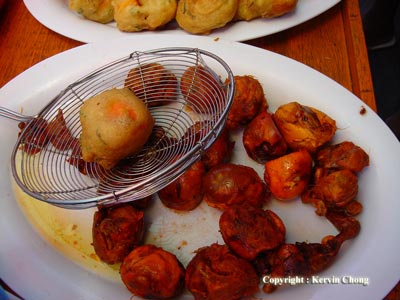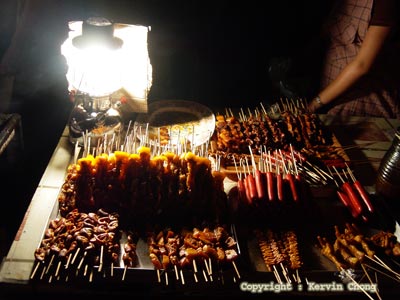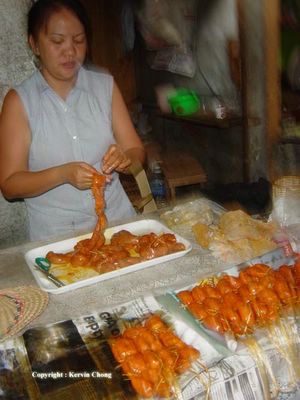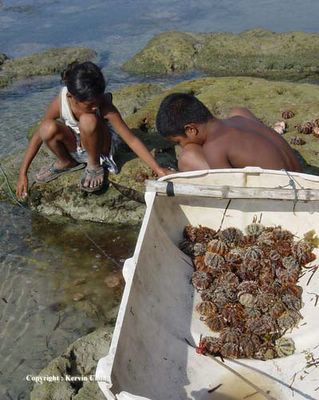The Philippines has many wonderful dishes that would wet any Malaysian palate. Dessert lovers would be thrilled with the mango season there where sweet heavenly mangoes goes for cheap prices and are used in many dishes from chutney, halo-halo and pickles. Ube is another favourite which we locals would refer to as yam (ubi kayu) and the ube ice cream there has a nice soft and milky texture with a rich hint of yam. Sinigang is a must try, simple to make, inexpensive and delicious. Sinigang is a fish broth made with milk fishes with lots of tamarind, ube powder, vegetables, potatoes and rice water. Kari kari is literally curry, served with either chicken or beef with rice. Longanisa is local sausages which differ by region but usually consists of stuffed meat and offal into the intestine of swine. Lumpiang is a popiah like treat with mengkuang stuffed with assorted vegetables and lathered in soy sauce. The influence of so many cultures such as the Spanish, Americans, Chinese and the locals have made it possible for a fushion of dishes and cooking styles of manifest in the local pallete.
Balut


Fried balut, Dagupan City, 2004.
The most famous dish that would be apparent to foreigners would be balut. They come in various forms mostly differing in the stage of development of the duck embryo but is generally a near formed duck embryo with the egg sac still attached to it. Picked a few days before the ducks actually reach full formed, balut can be taken raw, boiled or as in this picture deep fried. Whatever way you deem to eat it, you’ll find the duck near full formed sometimes with downy feathers present. Taken raw, you simply break the egg, slurp down the fluids and egg sac which people say taste like salty soup and then munch on the duckling. I chickened out and didn’t take it raw though I was tempted to try its taste instead opting for the more palatable fried version. The egg was boiled a while before being dipped in batter and deep fried. You can still make out the duckling. It tastes like a normal egg with a meaty consistency as you chew the duck meat but still a strong taste that last for a few hours in your mouth. You can dip the balut in a bowl of sauce mixed with lime, chillies and pineapples. It’s a dish not to be missed as its one of a kind and can’t be found elsewhere. In the Philippines, everyone eats it and its cheap (about 15 pesos/RM 1 for 3). It is easily found being sold in markets or hawked by hand.
Grill


Grilled chicken parts being sold at an open air stall, Bolinao, 2004.
Another common dish you’ll see being sold by the roadside is akin to satay or more appropriately Japanese Yakitori. These are various chicken parts being sold by the skewer and grilled over a coal fire. Nothing is apparently wasted (most probably due to poverty and the expensive nature of meat for some lower income families) and each is neatly skewered onto a stick. Thick sauce most probably fish based will be lathered onto the various skewers and this would in turn be grilled on an open coal fire. The more palatable ones that I could make out would be the meat sausage on a stick which is as the name implies is a hot dog generally. Other parts available are buttocks, breasts, fatty meat, gizzards, intestines, head and even feet.
Sausages


Lady stuffing meat and offal into the lining of an intestine to make sausages, Alaminos City, 2004.
There are a variety of sausages to be found called longanisa here. The norm is processed meat as what we find in the local supermarkets. This one caught my eye as it involves using the actual ileum of the pig and stuffing minced meat into the long tubular intestine with toothpicks used at intervals to form smaller portions. They’re sold in strips and all that you need to do is warm a skillet of oil, put some onions and garlic and just fry them for a few minutes till the intestine turns a little opaque and tough. The taste takes a bit of getting used to, it’s a bit tough due to the intestine and you might take a bit of effort to bite it off and chew. It still retains a bit of rawness to it after frying. This type can easily be found anywhere in the markets. Another more peculiar type of longanisa would the ones we found served at the University of the Philippines cafeteria and also in places like Vigan City. These are just minced meet, heavily spiced and flavoured and moulded into long strips. These are then fried and once done retains a dark brown hue with uneven skin texture. Its soft to then taste as it does not involve an outer intestine layer and is somewhat like minced meat. You can even get them with rice and eggs at the local Mc Donald’s breakfast meal.
Maratangtang


Children are often a regular sight seen hunting for sea urchins off the sea floor, here seen scooping the internal fillings to be sold, Patar beach, 2004.
Seafood is a big item here in the Philippines. Being an island nation, most of the people’s daily protein intake comes from catches from the ocean. Here’s a rather unusual treat but many would claim it is heavenly to the taste. Its maratangtang, or more commonly called the sea urchin. Demands for these are so high that Japanese buyers offer top dollar for the harvest and collection of these creatures for export. It has gotten to a point where sustainable harvesting of sea urchins are no longer feasible as over harvesting is the norm. UP has made it a point in studying the culturing and reintroduction of sea urchins back to the depleted wild stocks. Walk by the beach and you can see kids on bamboo rafts with a snorkel and their heads in the water slowly paddling offshore, at times reaching to the shallow sandy bottom and plucking up the thorny things. Later they would hack off the top and scoop out the eggs which are the main edible portion of the sea urchin. On a good day you’ll find hundreds of half broken shells on the beach, evidence of villagers collecting them. We had the chance to taste one, all it took was to use a knife to pry open the mouth and proceed to widen the opening, a spoon is then used to scoop up the gonads and eggs and is eaten raw. Some customers like to have them fried and used as seasoning with other dishes but the norm is for it to be taken as it is. I didn’t find out what all the fuss was about, it was like hard globs of tough rubber and with a hint of seawater, but some of my colleagues liked it.











No comments:
Post a Comment